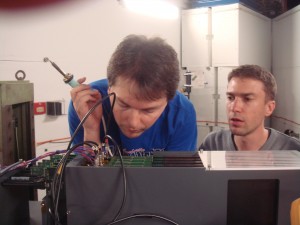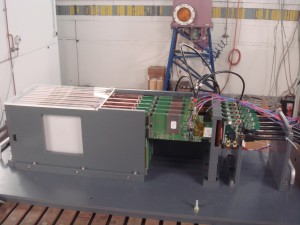
Engineers Stephane Callier (Omage) and Remi Cornat (LLR) setting up the SiW electromagnetic calorimeter.
Building a state-of-the-art particle detector requires several steps. When you’ve decided what you want to measure, you have to decide which is the best, fastest and most reliable technology to make these measurements. When you’ve shown that your chosen technology can actually measure things to the specific requirements, you have to show that you can actually build it into the space earmarked for it. The collaboration that builds one option for an electromagnetic calorimeter (ecal) for the ILC’s ILD detector has just passed the “technology works” step – the physics prototype – and is now starting on the next one – the technological prototype. It measures 18 by 18 by 20 centimetres and consists of a detector layer made of silicon (Si) and an absorber layer made of tungsten (W), which leads to the acronym SiW Ecal. They will take data in a test beam at DESY in Hamburg, Germany, early next year. The R&D for this detector, led by the French groups of Laboratoire Leprince-Ringuet (LLR) and LAL, is embedded into the programme of the CALICE collaboration.
Building a detector is always a complicated business, but there are some things that make ILC detectors just that bit more challenging. The calorimeters are core contributors to the particle flow algorithm, which will give the highest ever energy resolution for jets in a detector, making it possible to identify and track every single particle from a collision. These calorimeters need to fit into the magnet, so there’s a space challenge – not a new one, however; also the LHC detectors, big as they are, had to be squeezed into a fixed amount of space. So much electronics – particle flow requires many channels, and each channel must not consume more than 25 microwatts of power – alongside so many sensitive materials produce a lot of heat, and there isn’t really any space for an active cooling mechanism. So the detector developers have tackled the problem from the source: they want to make sure that heat isn’t even generated in the first place.
With the ILC’s pulsed beam cycle, when a bunch train has passed, there’s a gap that’s not noticeable for humans but can feel like a lifetime of inactivity (and unnecessary heat production) for the ultra-fast detector electronics. So why not take a real break before the next pulse comes through? The components aren’t actually switched off, but powered down in between cycles, a system called power pulsing. The team working on the SiW-ecal technological prototype are about to try it in a lab workshop in France, “but it’s a different story with real beam and with a magnet,” says Roman Pöschl from LAL.
The team, consisting of researchers from France and Japan, tested the technical prototype’s ability to acquire data in a conservative, i.e. continuous mode in summer 2012 and are now curious to see whether the signal quality is different when applying power pulsing.
The SiW ecal is very compact – because it needs to be due to its space in the overall ILC detector, but also because the materials used make it so. Tungsten, used as the absorber material that interacts with the particles flying through, producing a nicely narrow particle shower, is extremely dense, so very little of it is needed. Silicon supports the compactness because it allows for pixelisation. In addition it permits for building detectors that can detect small signals. This distinction of signal against everything else that is going on in a detector – aptly called ‘noise’ – is a fixed unit in particle physics called signal-to-noise ratio. The R&D goal for the SiW ecal was a signal-to-noise ratio of 10 to 1; in test beams they achieved between 14 and 20 to one, much better than needed. The modifications needed for power pulsing, however, can have a negative influence on the signal-to-noise ratio, and the team is after the exact rates. “We are confident that we can still reach or R&D goal,” says Roman Pöschl.


Recent Comments